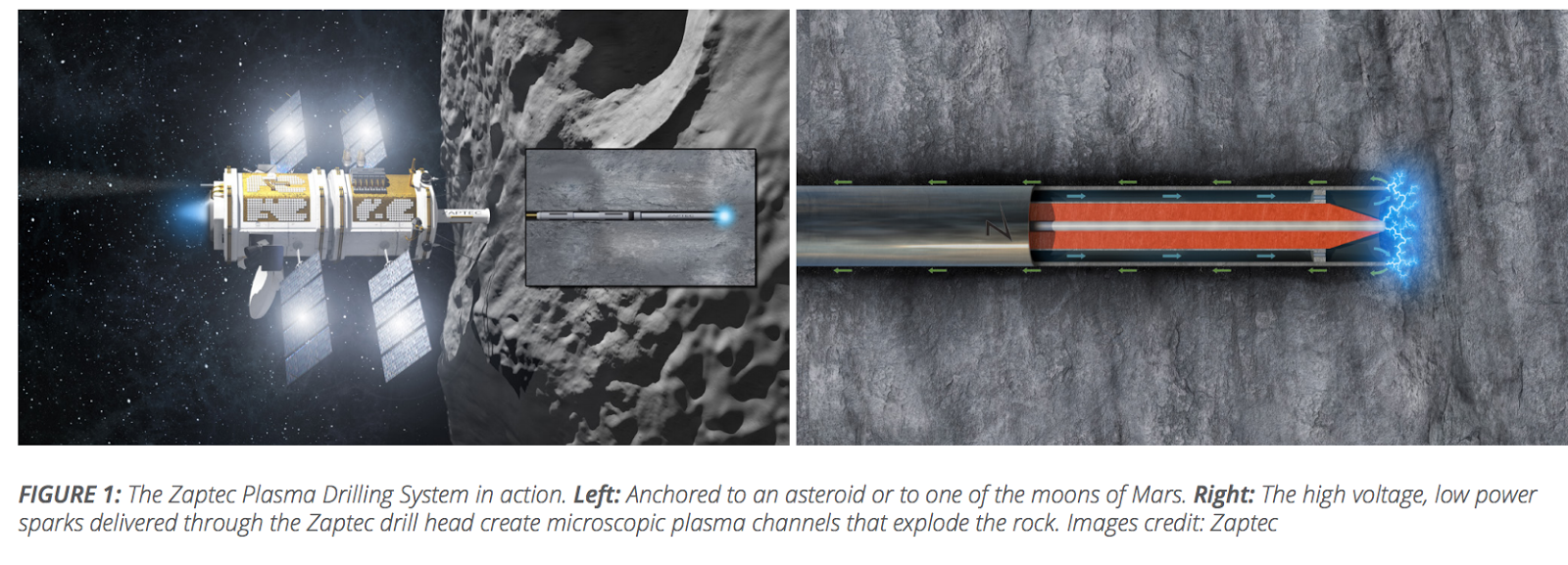Zaptec has a new plasma drilling technology which could achieve practical, affordable, and reliable deep drilling on the Moon, asteroids, Mars, and its moons. The drilling system comprises a freely advancing drill head tethered by a power cable to a power source topside and high voltage generator downhole. The drill advances by generating a high-energy density plasma at the drill head which breaks down and pulverizes the target rock. A key enabling technology is the system’s ability to deliver high energy plasma discharges via low mass, small volume power transformers located in the
drill head section. Powder cuttings may be removed by circulating compressed CO2.
Zaptec on the Moon
On the Moon, the subsurface in the polar regions may be a repository of volatiles of value to science and as a potential resource for future human exploration. A Zaptec drill could be deployed on a future robotic lunar lander mission, such as Moon Express, or in the context of human missions. The fine dust from drilling goes through the unit, is analysed, and then sprayed into a dust exhaust in contact with the surface vacuum. An alternative scenario is to expand the module with a processing unit which sorts out minerals from H2O/CO2 ice. The mineral dust can then be used as raw materials for local manufacturing.
Zaptec on Asteroids, the Moons of Mars, and Other Rocky Small Bodies
On asteroids, the subsurface may yield pristine asteroidal materials and potential resources for human exploration as well. The moons of Mars, Phobos and Deimos, are expected to present similar opportunities. Because the Zaptec approach does not require weight on bit, it is able to effectively drill into any rocky small body in microgravity. The Zaptec system is anticipated to reach 50 to 100 meter depths with less than 250 kg of gear topside and 1 kW of peak power.
Zaptec on Mars
On Mars, the subsurface might hold records of potential past life on Mars that might be better preserved than at the surface of Mars itself. The search for biosignatures and life on Mars is guided by NASA’s Follow the Water strategy. The H2O ice-rich subsurface on Mars likely transitions to liquid H2O-rich aquifers at greater depth, which might offer habitats for potential extant life on Mars.
The depth to liquid aquifers on Mars is estimated to range from a few tens of meters (if briny solutions are involved and/or in potentially active volcanic areas presenting elevated geothermal gradients) to a few kilometers. Hoftun et al. (2014) summarize deep drilling rationales and challenges on Mars, and suggest that liquid aquifers might be reached at depths of less than 1 to 2 km beneath the floor of Valles Marineris and in recently active volcanic provinces.
On Mars, the proposed Zaptec system will allow a depth of 2 km to be reached with less than 1 metric ton of surface payload housed in a SpaceX Dragon-sized capsule and peak power requirements of less than 2 kW.
Zaptec deep drilling system capable of reaching a depth of 2 km, deployed from a SpaceX Dragon-class landed capsule. Astronaut shown for scale (Image Credit: Zaptec). Right: An important goal of deep drilling on Mars will be to reach potential underground aquifers to search for any extant life. Image credit: Mars Institute. (Image Credit: Mars Institute. Background diagram: ESA).
Next Steps
The lightweight, energy-efficient Zaptec drilling concept, which is based on plasma channel drilling/electropulse, offers a promising and universal approach to planetary and small body drilling. The concept will continue to mature with laboratory and field tests over the next years.
From 2011-2013, we organized three International Planetary Drilling Workshops convened by Norway’s Space and Energy network in Stavanger, Norway. The development of the Zaptec concept for planetary exploration applications benefitted from these workshops. We plan to continue convening such workshops and encourage the international planetary exploration community interested in subsurface access to participate.
SOURCES – Zaptec, Youtube

Brian Wang is a Futurist Thought Leader and a popular Science blogger with 1 million readers per month. His blog Nextbigfuture.com is ranked #1 Science News Blog. It covers many disruptive technology and trends including Space, Robotics, Artificial Intelligence, Medicine, Anti-aging Biotechnology, and Nanotechnology.
Known for identifying cutting edge technologies, he is currently a Co-Founder of a startup and fundraiser for high potential early-stage companies. He is the Head of Research for Allocations for deep technology investments and an Angel Investor at Space Angels.
A frequent speaker at corporations, he has been a TEDx speaker, a Singularity University speaker and guest at numerous interviews for radio and podcasts. He is open to public speaking and advising engagements.



